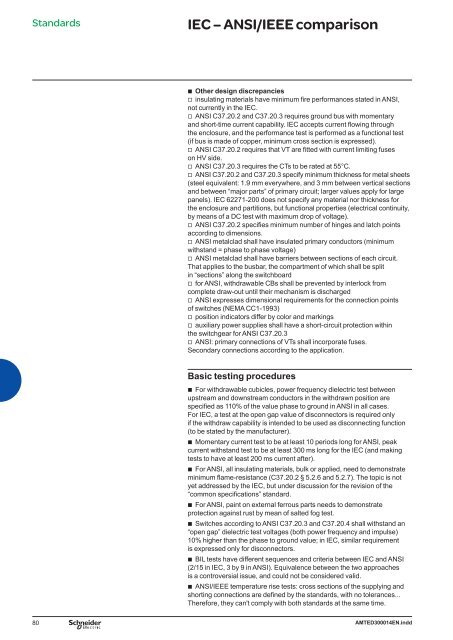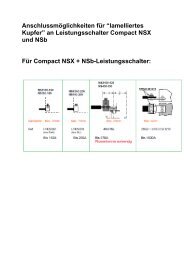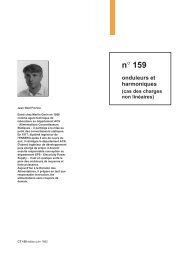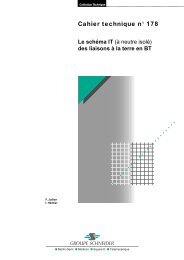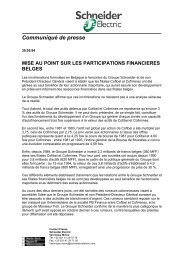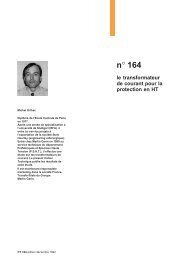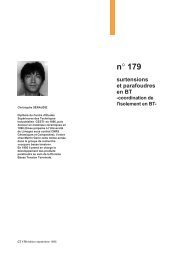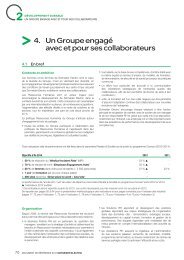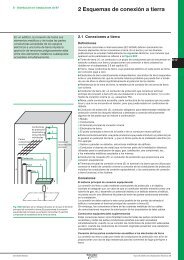Medium Voltage technical guide - Schneider Electric
Medium Voltage technical guide - Schneider Electric
Medium Voltage technical guide - Schneider Electric
You also want an ePaper? Increase the reach of your titles
YUMPU automatically turns print PDFs into web optimized ePapers that Google loves.
Standards IEC – ANSI/IEEE comparison<br />
b Other design discrepancies<br />
v insulating materials have minimum fire performances stated in ANSI,<br />
not currently in the IEC.<br />
v ANSI C37.20.2 and C37.20.3 requires ground bus with momentary<br />
and short-time current capability. IEC accepts current flowing through<br />
the enclosure, and the performance test is performed as a functional test<br />
(if bus is made of copper, minimum cross section is expressed).<br />
v ANSI C37.20.2 requires that VT are fitted with current limiting fuses<br />
on HV side.<br />
v ANSI C37.20.3 requires the CTs to be rated at 55°C.<br />
v ANSI C37.20.2 and C37.20.3 specify minimum thickness for metal sheets<br />
(steel equivalent: 1.9 mm everywhere, and 3 mm between vertical sections<br />
and between “major parts” of primary circuit; larger values apply for large<br />
panels). IEC 62271-200 does not specify any material nor thickness for<br />
the enclosure and partitions, but functional properties (electrical continuity,<br />
by means of a DC test with maximum drop of voltage).<br />
v ANSI C37.20.2 specifies minimum number of hinges and latch points<br />
according to dimensions.<br />
v ANSI metalclad shall have insulated primary conductors (minimum<br />
withstand = phase to phase voltage)<br />
v ANSI metalclad shall have barriers between sections of each circuit.<br />
That applies to the busbar, the compartment of which shall be split<br />
in “sections” along the switchboard<br />
v for ANSI, withdrawable CBs shall be prevented by interlock from<br />
complete draw-out until their mechanism is discharged<br />
v ANSI expresses dimensional requirements for the connection points<br />
of switches (NEMA CC1-1993)<br />
v position indicators differ by color and markings<br />
v auxiliary power supplies shall have a short-circuit protection within<br />
the switchgear for ANSI C37.20.3<br />
v ANSI: primary connections of VTs shall incorporate fuses.<br />
Secondary connections according to the application.<br />
Basic testing procedures<br />
b For withdrawable cubicles, power frequency dielectric test between<br />
upstream and downstream conductors in the withdrawn position are<br />
specified as 110% of the value phase to ground in ANSI in all cases.<br />
For IEC, a test at the open gap value of disconnectors is required only<br />
if the withdraw capability is intended to be used as disconnecting function<br />
(to be stated by the manufacturer).<br />
b Momentary current test to be at least 10 periods long for ANSI, peak<br />
current withstand test to be at least 300 ms long for the IEC (and making<br />
tests to have at least 200 ms current after).<br />
b For ANSI, all insulating materials, bulk or applied, need to demonstrate<br />
minimum flame-resistance (C37.20.2 § 5.2.6 and 5.2.7). The topic is not<br />
yet addressed by the IEC, but under discussion for the revision of the<br />
“common specifications” standard.<br />
b For ANSI, paint on external ferrous parts needs to demonstrate<br />
protection against rust by mean of salted fog test.<br />
b Switches according to ANSI C37.20.3 and C37.20.4 shall withstand an<br />
“open gap” dielectric test voltages (both power frequency and impulse)<br />
10% higher than the phase to ground value; in IEC, similar requirement<br />
is expressed only for disconnectors.<br />
b BIL tests have different sequences and criteria between IEC and ANSI<br />
(2/15 in IEC, 3 by 9 in ANSI). Equivalence between the two approaches<br />
is a controversial issue, and could not be considered valid.<br />
b ANSI/IEEE temperature rise tests: cross sections of the supplying and<br />
shorting connections are defined by the standards, with no tolerances...<br />
Therefore, they can't comply with both standards at the same time.<br />
80 AMTED300014EN.indd


